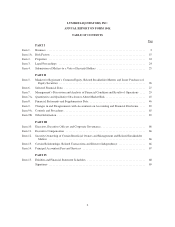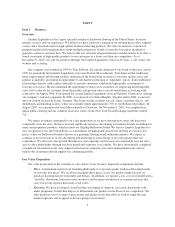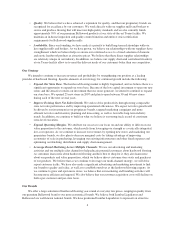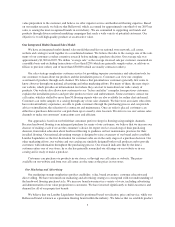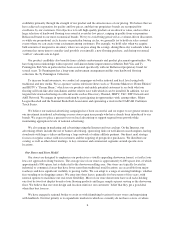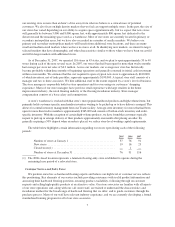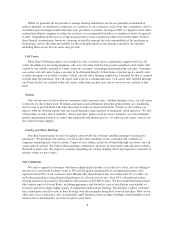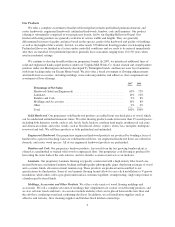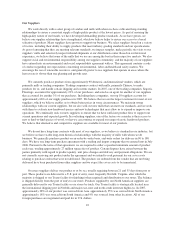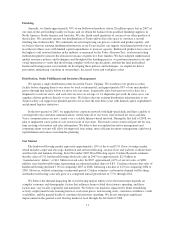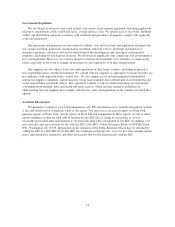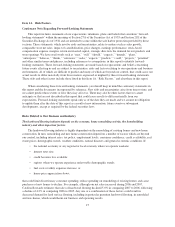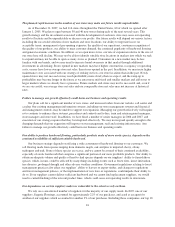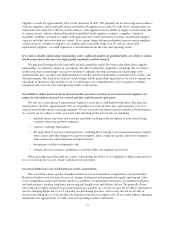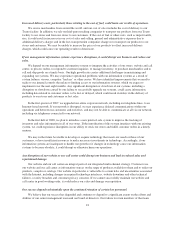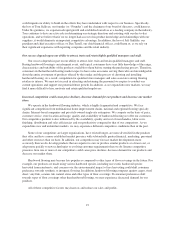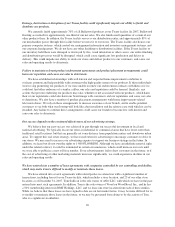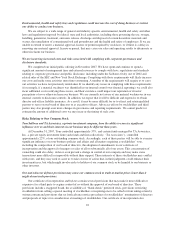Lumber Liquidators 2007 Annual Report Download - page 18
Download and view the complete annual report
Please find page 18 of the 2007 Lumber Liquidators annual report below. You can navigate through the pages in the report by either clicking on the pages listed below, or by using the keyword search tool below to find specific information within the annual report.Our total net sales, comparable net sales and average net sales per store older than one year all improved in
2007 compared to 2006. We believe the number of retailers serving the homeowner-based segment of the wood
floor market declined in 2007, and our results benefited from increased market share. While the housing market
may continue to be volatile, we also believe we will continue to benefit from several key long-term industry
trends and characteristics including:
•Increased Home Improvement Spending.Based on the U.S. Census Bureau construction report,
residential improvement spending grew at a 7.0% compound annual growth rate from 2000 to 2005.
According to the Home Improvement Research Institute, spending on home improvement products is
forecasted to grow at a 5.2% compound annual growth rate from 2005 to 2010. The home improvement
market is driven by several factors, which include the age of the existing housing stock, home
ownership levels, average home size and demographic shifts in the population. We believe home
improvement spending is currently being driven in particular by persons engaged in home remodeling
projects.
•Aging Housing Stock. As homes get older, homeowners remodel in order to maintain habitability,
marketability and attractiveness of the home. Also, as homes get older, materials such as floor
coverings that were used at the time of initial construction wear out and must be replaced or
upgraded to compete with new homes. According to the U.S. Census Bureau, the median age of
the U.S. housing stock was 33 years in 2005, which compares to 25 years in 1990.
•Increasing Home Ownership. Data from the U.S. Census Bureau shows that the home ownership
rate was 68% and owner-occupied homes totaled 75.2 million in the fourth quarter of 2007, a
long-term increase from the fourth quarter of 1995, where the home ownership rate was 65% and
owner-occupied homes totaled 65.4 million. Homeowners are significantly more likely to spend
on residential improvements than landlords and renters. According to the Joint Center for Housing
Studies of Harvard University, homeowners increased their residential improvement expenditures
10% annually from 2000 to 2005, while owners of rental properties have increased their spending
by less than 4% annually over the same period.
•Increasing Average Size of Homes. As homes have increased in average size, there is more floor
surface to be covered. According to the U.S. Census Bureau, the average new single family home
was estimated to be 2,469 square feet in 2006, a 17.9% increase from 2,095 square feet in 1995.
•Favorable Demographic Trends. Purchases by households with more discretionary income have
driven increased hardwood flooring sales. Catalina estimates that households with incomes of
$70,000 or more made approximately 60.9% of total hard surface flooring purchases in 2005, up
from 32.8% in 1997. The population segment represented by this income bracket was one of the
most quickly growing over the past decade. Similarly, households headed by people between 35
and 64 years of age tended to dominate total hard surface flooring purchases, representing 64.1%
of purchases in 2005, up from 63.8% in 1997. The most significant change in this category,
however, was in the age segment category 45 to 64, representing 48.3% of total hard surface
flooring purchases in 2005, up from 41.1% in 1997. This segment’s population will continue to
grow, as the U.S. Census Bureau projects the 45 to 64 age segment to increase to 26.2% of the
population by 2010 (up from 22.1% of the population in 2000). This constitutes the largest
estimated population increase of any age group over that period.
•Evolution of the Hardwood Flooring Market. Manufacturers today offer a wider range of wood
species than they have historically, including exotic woods and bamboo, as well as distressed and
handscraped flooring lines that appeal to a wider range of consumers. Additionally, manufacturers have
designed hardwood flooring that is increasingly easier and less costly to install, such as prefinished,
engineered floors that can be installed without glue. Prefinished hardwood floors have become highly
prevalent due to ease of installation, multiple styles and applications for situations that in the past
precluded the use of hardwood floors. Unfinished products usually require professional installation,
sanding and multiple coats of varnish. According to industry sources, the percentage of prefinished
square feet of flooring sold increased from 38% in 1999 to over 50% estimated for 2007.
12


